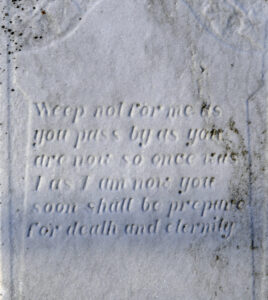Refocusing Our Audience
Mapping Cemeteries is a Digital Humanities (DH) project in conversation with academic and non-academic audiences who are seeking accessible audiovisual resources that explore our complex relationships to death. With these subjects in mind, Mapping Cemeteries begins its first phase with the graduate students of the Spring 2021 Digital Humanities Praxis course with Dr. J. Bret Maney as its primary audience.
As a setting ripe with individuals who self identify as digital humanists, archivists, researchers, artists, and technologists, Mapping Cemeteries intends to engage peers and allies of the DH field, such as the Spring 2021 Praxis course, to assess its humanistic topic and technological utility. The team behind the first phase of Mapping Cemeteries wants to know how their humanistic topic and technological choices produce an overall public access to the project’s mission.
Teammates self-assigned to text analysis, research, and project management tasks conducted a small textual analysis project referred to as text mining in the literary and DH fields. This type of analysis was facilitated through text mining website, Voyant, and selected to assess, filter, and categorize the scope of data on DH skills and any relevant professional minutia of the primary audience based on their self-volunteered professional biographies from the Spring 2021 Praxis course site, DHUM 70002 Digital Humanities: Methods and Practices (Spring 2021).
We are presenting our project to them on May 6, 2021, and we are eager to hear their feedback on the concept, design, and user experience. As we are also documenting the process of creating this project–via personal and group blog posts and a special audio project on our journey–an additional audience is students taking this class in the future, and more broadly people building digital humanities projects for the first time.
We are presenting our project to a wider Graduate Center (GC) and CUNY academic community on May 13, so attendees are also one of our primary audiences. We are considering a survey for our audiences on the general and key areas of Mapping Cemeteries to gather more feedback on the concept, design, and user experience for its current and future phases. We are approaching this presentation as a “soft launch” of our project before we share it more widely with future audiences.
Secondary audiences we want to reach with our project include other scholars studying digital memory and cemeteries. We will connect with our contacts at the GC to help us reach out to peers studying these topics at other institutions.
We also envision our project as filling a space within “forgotten” (or at least lesser known) New York City history. We will reach out to local historians as well as walking tour guides and other practitioners of alternative tourism to share our findings and our project.
Working with an End in Mind
We are exploring and collecting data from five different cemeteries/memorials, guided by our research question “Who gets to be remembered?” With this in mind, we envision Mapping Cemeteries comprising the following components:
- A splash page (i.e. first page the user sees when they visit the main URL) with a map of New York City with five mapping points for our five locations. The user can tap any of these points, and the browser takes them to that location’s page on our site. If they tap anywhere else, the user goes to the homepage.
- A homepage featuring both a horizontal timeline and a vertical timeline.
- Horizontal timeline: Could be by years with some key information about NYC, like increases in population, creation of the current grid, incorporation of Brooklyn, etc. Also here can be time points for important dates for our five locations. The idea would not be to create a comprehensive timeline of NYC history, but rather to sit our research into a large context of what was happening with the land as the population expanded.
- Vertical timeline: This could be used as a conversation between scholars (us) discussing our locations within our greater narrative.
- Data subpages for each location that incorporate information and a fuller narrative–both narrative and audio–on our specific locations. The information here could also be used to create a Clio tour.
Key Deliverables
We will each have decided which cemetery/memorial location we are researching by March 4.
We have already begun discussing how we will gather data and how we can store it, and we will have a revised data management plan by March 5.
We have already been discussing the many different ways we can approach outreach, including but not limited to social media platforms. We will have a revised outreach plan by March 12.
We will have a wireframe of the site constructed by March 19.
We will focus the last half of March and first half of April on organizing our data and crafting our narrative.
We will be presenting our project to our class on May 6, and then in the Digital Showcase on May 13.

[This entry was originally posted to DHUM 70002 Digital Humanities: Methods and Practices (Spring 2021) in Group Project Updates and tagged group project updates, mapping cemeteries on March 2, 2021.]








